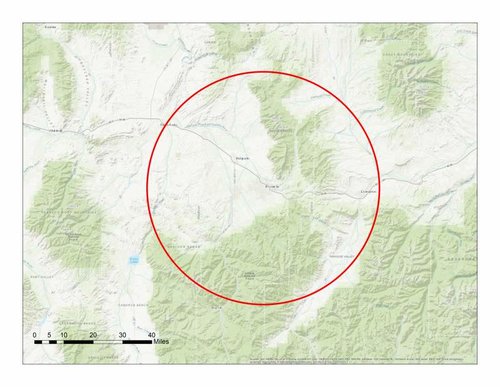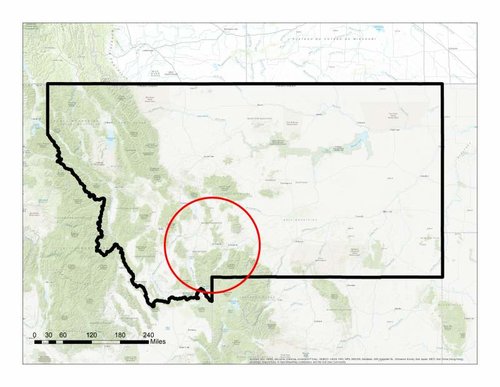joelweb
Well-known member
New Study Shows 9.52 Million Acres of Western Public Lands Are Landlocked
Results of the most sophisticated analysis of inaccessible public lands reveals a staggering challenge that the Land and Water Conservation Fund could help solve
BOZEMAN, Mont. — This week, onX and the Theodore Roosevelt Conservation Partnership revealed the stunning results of a collaboration to quantify how many acres of America’s public lands are entirely surrounded by private land and, therefore, sit inaccessible to hunters, anglers, and other outdoor recreationists.
The Findings
More than 9.5 million acres across thirteen states in the American West were identified as landlocked by private lands in a study using today’s leading mapping technologies. The findings are now available in a new report, “Off Limits, But Within Reach: Unlocking the West’s Inaccessible Public Lands,” which unpacks the issue in unprecedented detail.
“At 9.52 million acres, the massive scale of the landlocked problem represents a major impediment to public access and the growth of the $887-billion outdoor recreation economy,” says Joel Webster, Western lands director with the Theodore Roosevelt Conservation Partnership. “These are lands that all Americans own, and yet public access is not readily available or guaranteed.”
Up until now, little has been done to make a comprehensive and detailed assessment of this frequently discussed issue. This new report breaks down the 9.52 million acres landlocked across the West into totals for each of the thirteen states, highlighting the largest landlocked parcel within each state and how many landlocked acres each federal land management agency oversees.
More than 93.2 percent of landlocked public lands in the West are managed by the Bureau of Land Management. Wyoming holds the most inaccessible public lands with 3.05 million acres—or almost a third of the total landlocked acreage across the region.
“onX was founded on helping people access the outdoors and public lands, and our partnership in this project is an extension of that,” says onX founder Eric Siegfried. “In additions to creating technology that enables people to make memories in the field or on the water, we strongly support efforts that either improve current access points or open up new opportunities for our customers. Why not start with the public lands that we rightfully own?”
A Solution in Jeopardy
The report also highlights the most powerful tool for opening landlocked lands to the public—the Land and Water Conservation Fund, which, among other things, pays for voluntary easement and acquisition agreements with private landowners. This joint effort between onX and TRCP arrives at a critical time for the fund, which is set to expire on September 30, 2018, unless Congress acts to reauthorize the LWCF.
“Our report offers a clear and accurate picture of a major access obstacle facing public land users, and the Land and Water Conservation Fund is the single most important mechanism for addressing this challenge,” says TRCP’s Webster. “Many lawmakers talk about their commitment to public access, and the clearest way for them to demonstrate their support would be to reauthorize this critical program by September 30.”
“Many public land parcels without guaranteed public access range from five to 30 square miles in size—we aren’t just talking about postage stamp sections,” adds Siegfried. “Understanding this, lawmakers have a very real opportunity to make a positive difference by expanding public access for the American people, and we hope they do.”
Landlocked Acres by State
• Arizona: 243,000 acres
• California: 492,000 acres
• Colorado: 269,000 acres
• Idaho: 208,000 acres
• Montana: 1,523,000 acres
• Nevada: 2,054,000 acres
• New Mexico: 554,000 acres
• North Dakota: 107,000 acres
• Oregon: 443,000 acres
• South Dakota: 196,000 acres
• Utah: 264,000 acres
• Washington: 121,000 acres
• Wyoming: 3,046,000 acres
Learn more and download the full report at unlockingpubliclands.org.
Results of the most sophisticated analysis of inaccessible public lands reveals a staggering challenge that the Land and Water Conservation Fund could help solve
BOZEMAN, Mont. — This week, onX and the Theodore Roosevelt Conservation Partnership revealed the stunning results of a collaboration to quantify how many acres of America’s public lands are entirely surrounded by private land and, therefore, sit inaccessible to hunters, anglers, and other outdoor recreationists.
The Findings
More than 9.5 million acres across thirteen states in the American West were identified as landlocked by private lands in a study using today’s leading mapping technologies. The findings are now available in a new report, “Off Limits, But Within Reach: Unlocking the West’s Inaccessible Public Lands,” which unpacks the issue in unprecedented detail.
“At 9.52 million acres, the massive scale of the landlocked problem represents a major impediment to public access and the growth of the $887-billion outdoor recreation economy,” says Joel Webster, Western lands director with the Theodore Roosevelt Conservation Partnership. “These are lands that all Americans own, and yet public access is not readily available or guaranteed.”
Up until now, little has been done to make a comprehensive and detailed assessment of this frequently discussed issue. This new report breaks down the 9.52 million acres landlocked across the West into totals for each of the thirteen states, highlighting the largest landlocked parcel within each state and how many landlocked acres each federal land management agency oversees.
More than 93.2 percent of landlocked public lands in the West are managed by the Bureau of Land Management. Wyoming holds the most inaccessible public lands with 3.05 million acres—or almost a third of the total landlocked acreage across the region.
“onX was founded on helping people access the outdoors and public lands, and our partnership in this project is an extension of that,” says onX founder Eric Siegfried. “In additions to creating technology that enables people to make memories in the field or on the water, we strongly support efforts that either improve current access points or open up new opportunities for our customers. Why not start with the public lands that we rightfully own?”
A Solution in Jeopardy
The report also highlights the most powerful tool for opening landlocked lands to the public—the Land and Water Conservation Fund, which, among other things, pays for voluntary easement and acquisition agreements with private landowners. This joint effort between onX and TRCP arrives at a critical time for the fund, which is set to expire on September 30, 2018, unless Congress acts to reauthorize the LWCF.
“Our report offers a clear and accurate picture of a major access obstacle facing public land users, and the Land and Water Conservation Fund is the single most important mechanism for addressing this challenge,” says TRCP’s Webster. “Many lawmakers talk about their commitment to public access, and the clearest way for them to demonstrate their support would be to reauthorize this critical program by September 30.”
“Many public land parcels without guaranteed public access range from five to 30 square miles in size—we aren’t just talking about postage stamp sections,” adds Siegfried. “Understanding this, lawmakers have a very real opportunity to make a positive difference by expanding public access for the American people, and we hope they do.”
Landlocked Acres by State
• Arizona: 243,000 acres
• California: 492,000 acres
• Colorado: 269,000 acres
• Idaho: 208,000 acres
• Montana: 1,523,000 acres
• Nevada: 2,054,000 acres
• New Mexico: 554,000 acres
• North Dakota: 107,000 acres
• Oregon: 443,000 acres
• South Dakota: 196,000 acres
• Utah: 264,000 acres
• Washington: 121,000 acres
• Wyoming: 3,046,000 acres
Learn more and download the full report at unlockingpubliclands.org.






